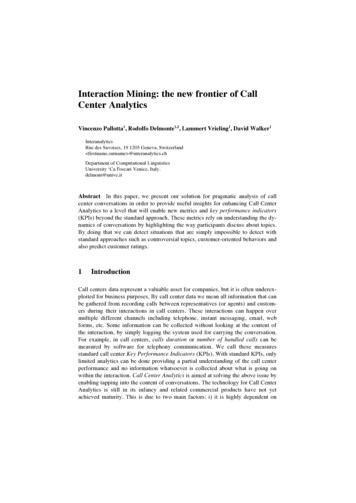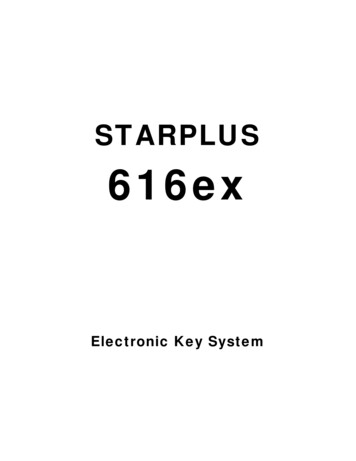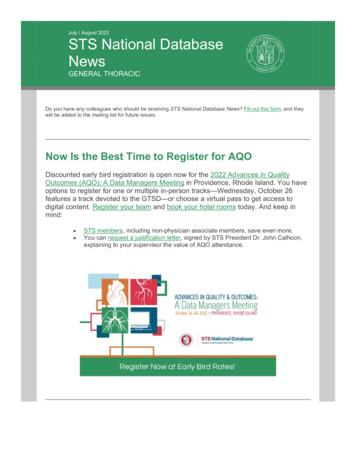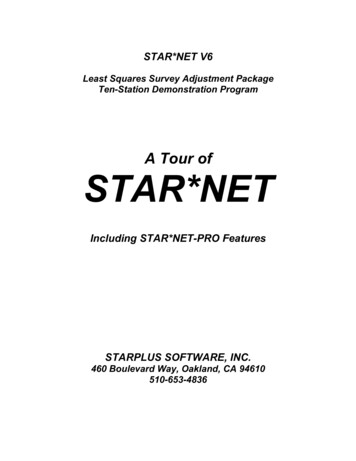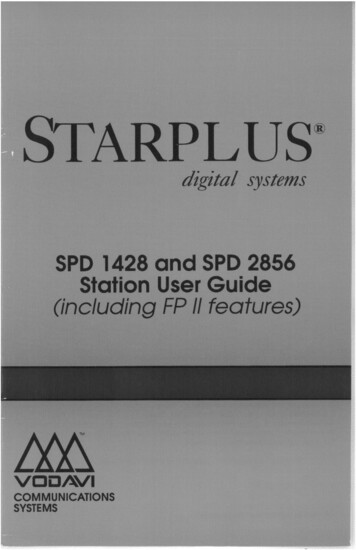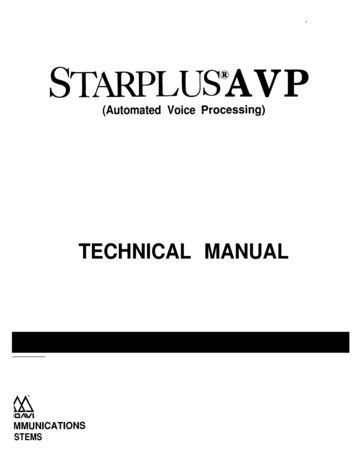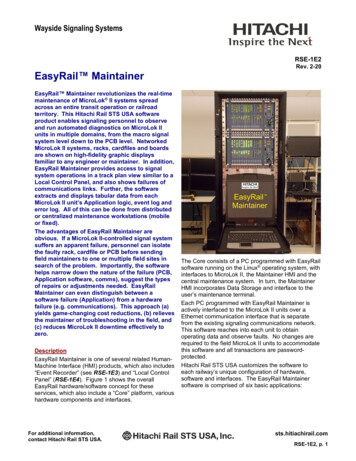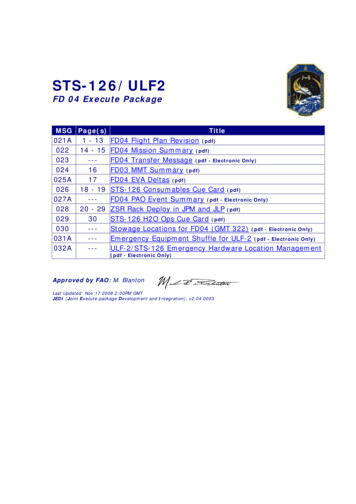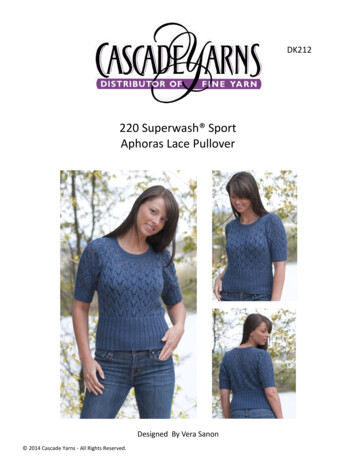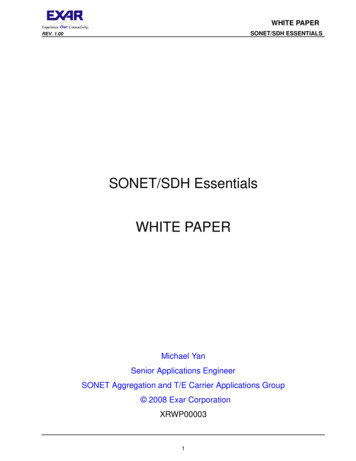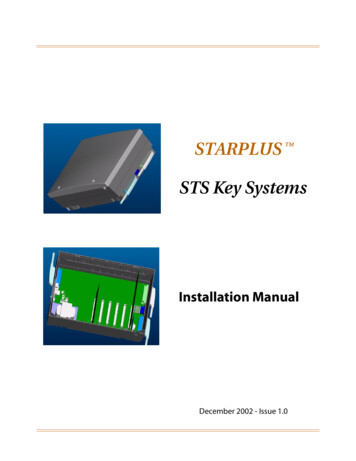
Transcription
STARPLUSTMSTS Key SystemsInstallation ManualDecember 2002 - Issue 1.0
IssueRelease Date112-02ChangesInitial ReleaseLIFE SUPPORT APPLICATIONS POLICYVODAVI Communications Systems products are not authorized for and should notbe used within Life Support applications. Life Support systems are equipmentintended to support or sustain life and whose failure to perform when properly usedin accordance with instructions provided can be reasonably expected to result insignificant personal injury or death.VODAVI Communications Systems warranty is limited to replacement of defectivecomponents and does not cover injury to persons or property or otherconsequential damages.Copyright 2002 VODAVI Technology, Inc.All Rights ReservedThis material is copyrighted by VODAVI Technology, Inc., and may be duplicated by AuthorizedDealers only. Any unauthorized reproductions, use or disclosure of this material, or any partthereof, is strictly prohibited and is a violation of the Copyright Laws of the United States(17 U.S.C. Section 101 et. seq.).VODAVI reserves the right to make changes in specifications at any time and without notice. Theinformation furnished by VODAVI in this material is believed to be accurate and reliable, but isnot warranted to be true in all cases.STARPLUS is a Registered trademark of VODAVI Technology, Inc.seh/2002
Regulatory Information (U.S.A.)The Federal Communications Commission (FCC)established rules to allow the direct connection of theSTS to a telephone network. Certain actions must beundertaken or understood before the connection ofcustomer provided equipment is completed.Telephone Company NotificationBefore connecting the STS to the telephone network,the local serving telephone company must be givenadvance notice of intention to use customer providedequipment, and must be provided with the followinginformation:Telephone NumbersThe telephone numbers to be connected to the system.STS System Information The Ringer Equivalence Number is also located onthe KSU: 1.3BThe USOC jack required for direct interconnectionwith the telephone network: RJ21FCC Registration Numbers: For systems configured as a key system: (buttonappearances) 5JYKF06BV70For systems configured as a Hybrid system: (dialaccess codes) 5JYMF06BV70Incidence of HarmIf the telephone company determines that the customerprovided equipment is faulty and possibly causing harmor interruption to the telephone network, it should bedisconnected until repairs can be made. If this is notdone, the telephone company may temporarilydisconnect service.Changes in ServiceThe local telephone company may make changes in itscommunications facilities or procedures. If thesechanges affect the use of the STS or compatibility withthe network, the telephone company must give writtennotice to the user to allow uninterrupted service.Maintenance LimitationsMaintenance on the STS System must be performedonly by the manufacturer or its authorized agent. Theuser may not make any changes and/or repairs except asspecifically noted in this manual. If unauthorizedalterations or repairs are made, any remaining warrantyand the software license for the system will be voided.Hearing Aid CompatibilityAll STS Digital Terminals are Hearing Aid Compatible, asdefined in Section 68.316 of Part 68 FCC Rules andRegulations.UL/CSA Safety ComplianceThe STS System has met all safety requirements and wasfound in compliance with the Underwriters Laboratories(UL) 1459. This system is authorized to bear the “NRTL/C”marking.Notice of ComplianceThe STS System complies with rules regarding radiationand radio frequency emissions by Class A computingdevices. In accordance with FCC Standard 15 (Subpart J),the following information is supplied to the end user:“This equipment generates and uses RF energyand if not installed and used in accordance withthe Instruction Manual, may cause interference toRadio Communications. It has been tested andfound to comply with the limits for a Class A computingdevice, pursuant to Subpart J of Part 15 of the FCC Rules,which are designed to provide reasonable protectionagainst such interference, when operated in a commercialenvironment. Operation of this equipment in a residentialarea is likely to cause interference, in which case the user, athis own expense, will be required to take whatevermeasures may be required to correct the interference.”Toll Fraud and DISA Disclaimer“While this device is designed to be reasonably secureagainst intrusions from fraudulent callers, it is by nomeans invulnerable to fraud. Therefore, no express orimplied warranty is made against such fraud includinginterconnection to the long distance network.”“While this device is designed to be reasonably secureagainst invasion of privacy, it is by no meansinvulnerable to such invasions. Therefore, no express orimplied warranty is made against unlawful orunauthorized utilization which results in the invasion ofone’s right of privacy.”Vodavi has made every reasonable effort to ensure thatthis product works in most business environments.However, there may be some environments (RFI and EFI)in which this product may not work properly. In suchcases, it is the responsibility of the installer to take thenecessary actions to correct the situation.
Contents - iContents1IntroductionGeneral Information . 1-3System Overview . 1-3System Interface Boards . 1-3CO Circuitry . 1-3System Programming / Database . 1-3Keyset / DSS Console . 1-3Software Upgrades . 1-3Key Service Unit . 1-4Basic Cabinet . 1-4Basic System Configuration . 1-4Main Board Unit . 1-5Single Line Interface Board (2 port) . 1-5Ring Generator Unit . 1-5Expansion Cabinet . 1-6Built-in Power Supply . 1-6Extension Boards . 1-6Digital Telephone Interface Board (8 port) . 1-6Single Line Telephone Interface Board (4 port) . 1-7CO Interface Boards . 1-7Loop Start CO Line Interface Board . 1-7T1 Interface Board . 1-7Add-On Boards . 1-8Message Wait Unit . 1-8Modem Unit . 1-8Phase Lock Loop Unit . 1-82System SpecificationsConfiguration Tables . 2-3System Capacity . 2-3Visual Specifications . 2-4CO Line Buttons . 2-4DSS/BLF Buttons . 2-5Feature/Function Buttons . 2-5Tone Specifications . 2-6Audible Signals . 2-6Miscellaneous Specifications . 2-7System Part Numbers . 2-93InstallationInstallation Overview . 3-3
Contents - iiBasic Process . 3-3Site Preparation . 3-3General Site Considerations . 3-3Backboard Installation . 3-4Verify On-Site Equipment . 3-4KSU Mounting . 3-5Basic Cabinet . 3-5Expansion Cabinet . 3-6System Preparation . 3-6KSU Grounding . 3-6Grounding Instructions . 3-6Built-in Power Supply . 3-7Battery Backup Unit Installation . 3-7Battery Backup Wiring . 3-7System Backup Duration . 3-7System Battery Replacement - WARNING . 3-7Power Line Surge Protection . 3-8Lightning Protection . 3-8KSU AC Power Plug . 3-8Cable Connections . 3-8PCB Handling and General Installation . 3-9Inserting a PCB . 3-9Card Slot Configuration . 3-9Board Capacity . 3-9Card Slot Positions . 3-10BKSU & Main Board Unit Assembly . 3-11Main Board Unit . 3-11Initialize Default Settings . 3-11Retain Database . 3-11Digital Telephone Interface Board (built-in) . 3-12Loop Start CO Interface Board (with Caller ID) . 3-12Installing CIDU to Built-In LCOB . 3-12Single Line Interface Board (2 Port with built-in Msg Wait) . 3-13Expansion Board Installation . 3-14Digital Telephone Interface Board . 3-14Loop Start CO Interface Board (with Caller ID) . 3-14Installing CIDU Board to LCOB . 3-15Single Line Interface Board - 4 Port . 3-15Message Wait Unit . 3-15T1 Interface Board . 3-16Phase Lock Loop Unit . 3-19DTMF Tone Detection Units . 3-20Flash-Based Voice Mail System . 3-20Installing the Voice Mail Interface Board . 3-21Installing the Memory Expansion Module . 3-21
Contents - iiiModem Unit . 3-21Single Line Adapter . 3-23Station/CO Wiring . 3-24Digital & Single Line Wiring . 3-24Digital Stations . 3-24Single Line Stations . 3-24Digital Keyset & Terminal Wiring . 3-27Single Line Telephone Wiring . 3-27Keyset/Headset Installation . 3-28Wall Mounting the Digital Keyset . 3-28Installing a Headset . 3-29System Checkout . 3-29Preliminary Procedures . 3-29Power Up Sequence . 3-304Maintenance and TroubleshootingSystem Programming and Verification . 4-3Telephone and Terminal Troubleshooting . 4-3Keyset Self Test . 4-4Keyset LCD/LED Test . 4-4Keyset Button Test . 4-5DSS LED/Button Test . 4-5Key Telephones/Terminals . 4-6Single Line Telephones . 4-6DSS/BLF Console . 4-7CO Line Card Functions . 4-7System Functions . 4-8Remote Maintenance . 4-9General Overview . 4-9Maintenance Command Format . 4-9Maintenance Password . 4-9Exit Maintenance . 4-9System Configuration . 4-10Station Configuration . 4-11CO Line Configuration . 4-12Event Trace Buffer . 4-13DTMF Receiver Trace . 4-14Basic Format for Commands . 4-14Examples . 4-14Remote System Monitor . 4-14General Overview . 4-14Monitor Password . 4-15Help Menu . 4-15Dump Memory Data . 4-15Event Trace Mode . 4-16
Contents - ivModify Memory Command . 4-17Exit the Monitor Mode . 4-18SMDR . 4-18
Figures - vFiguresBuilt-In LCOB with CIDU .SLIB2 (2 port) .DTIB (8 Port) .LCOB with CIDU .SLIB (4-Port) with MSGU48 .T1IB (24 channel) with two DTRUs .PLLU Location .Flash-Based Voice Mail Card .MODU Installation Location .SLA (Single Line Adapter) .Digital Station Jack Wiring .Single Line Telephone Wiring .Maintenance Help Menu .System Configuration .Station Configuration .CO Line Configuration .Help Menu .Trace Mode Status .Enable Event Trace .Event Trace .SMDR Printout -94-104-114-124-154-164-174-184-19
Tables - viTablesFunction Capacity .Visual Signals - CO Line Buttons .Visual Signals - DSS/BLF Buttons .Visual Signals - Feature / Function Buttons .Signals To Called Station (Digital Station) .Signals To Calling Station .Dialing Specifications .Electrical Specifications .Environmental Specifications .Dimensions and Weights .STS Part Numbers .T1 Switch Positions .T1 Ordering Specifications .T1 Ordering Information .Call Routing Criteria .Call Routing Display Format .Telco to T1IB Interconnect Diagram - Pin Connections .Power Supply Tests .Flash Rates .Key Telephones/Terminals .Single Line Telephone .DSS/BLF Console .
All STS Digital Terminals are Hearing Aid Compatible, as defined in Section 68.316 of Part 68 FCC Rules and Regulations. UL/CSA Safety Compliance The STS System has met all safety requirements and was found in compliance with the Underwriters Laboratories (UL) 1459. This system is authorized to bear the "NRTL/C" marking. Notice of Compliance
